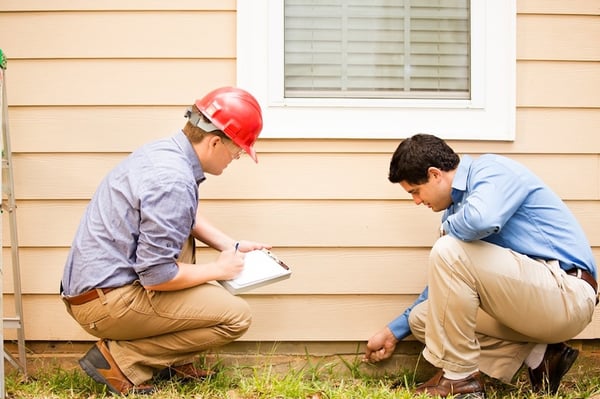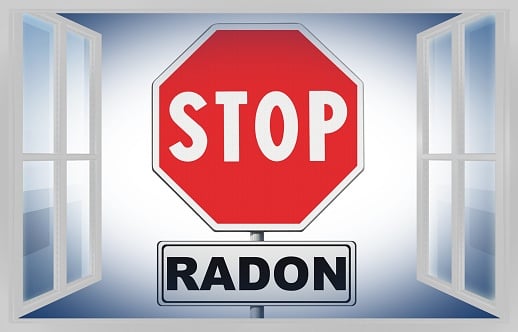Radon is a colorless, odorless, radioactive gas that comes from decaying uranium.
Radon is present in nearly all soils, and very low levels of radon gas are found in the air we breathe every day.
Problems arise when radon gas enters your home and gets trapped.
If you're exposed to radon over long periods of time, you may develop lung cancer. Radon poisoning is the second leading cause of lung cancer, right behind cigarettes.
Radon gas begins in the soil, and enters your home through cracks in your walls or foundation. Any house, of any age, in any state can have elevated radon levels.
The amount of radon gas that gets into your home depends on how much radon is present in the soil surrounding your house, and how your house interacts with the soil.
Your neighbors home could be completely safe, while you're radon levels could prove to be dangerous. That's why it is important to know you;re levels, and not just assume you're safe.
So, how do we get rid of radon? If elevated levels are due to the gas being trapped inside, is opening the windows enough to make your house safe?
We'll look at that and more below.
Table Of Contents
Is Opening Your Windows Enough?
It makes logical sense that is dangerous air is trapped in your home, that all you would need to do is open your windows to let it out.
However, opening your windows has a minimal impact on your home's radon levels.
And, even if your radon levels are reduced when the windows are open, they will return to their unsafe levels once you close them again.
The air pressure in your home is less than the pressure in the soil. This causes the gas to easily transfer from the ground into your home.
Opening the windows in your home will help equalize the air pressure, but it will also cause a stack effect, thrusting the air upward toward the roof of the house due to air pressure differences.
So instead of keeping your windows open in an attempt to reduce radon levels, you should consider venting the spaces near the floor such as your basement or crawl space.
Reducing the radon levels in these areas will help to reduce the radon levels in the house above.
But, it's important to remember that natural ventilation methods are only temporary, and shouldn't be used exclusively if your home has high levels of radon.
How To Remove Radon
Test
The first thing you need to do when removing radon from your home is to know what your levels are. That's where radon testing comes in.
There are three types of tests you can do for radon. The first type of test is a short-term test.
Short-term tests are useful to see if further testing is warranted. Most of the tests are activated charcoal-based or electret ion that measures radon levels for two to seven days.
Once the test is finished, you mail the tests to a lab for the results. Short-term tests are available at most big box stores, hardware stores, and online retailers.
For a more detailed and accurate report of the radon levels in your home, you should do a long-term test.
Long-term tests measure radon levels for 90 days to a year.
The long-term tests give a more accurate reading of your average annual levels in your home, which can vary significantly from day to day or month to month.
Factors like a drop in air pressure, gusty winds, changes in the soil, and snow cover all impact the radon levels in your home.
You can get a long-term test at a state radon agency or online retailers.
Removing The Gas
Now that you've been tested and you've found that the levels of radon in your house are elevated, it's time to remove the radon.
The first thing you need to do to make sure everything is done correctly, and so your family isn't at risk of developing lung cancer, is hire a certified professional.
You can contact the radon office in your state for a list of certified radon contractors who can help you take care of your radon problem.
Lowering high radon levels requires technical knowledge and special skills.
You should always use a contractor who is trained to treat radon problems. A qualified contractor can study the radon problem in your home and help you pick the right treatment method.
Now, even though you have a professional on your side, you should still educate yourself and study the various radon reduction systems.
One of the more effective radon reduction systems is an active soil depressurization system, and it works by pulling radon from the soil before it can enter your home.
The system can be installed inside of your home and vented through your roof. Or, it can be affixed to the exterior of your house.
Your radon specialist will inspect your home and recommend the best system for you.
As an extra measure, you can caulk cracks in your home's foundation, walls, lowest-level floors, and any other openings. Seal the lid in your sump pump as well.
Doing this will make it even harder for radon gas to enter your home.
Want to learn more about hiring a radon mitigation service? Read our blog post: "How to Choose the Best Radon Mitigation Company."

Call The Professionals
If you're ready to make sure your home is safe from radon poisoning, it's time to call the professionals.
You don't want your family to spend another day in a home that could be potentially giving them lung cancer.
To get started, reach out to the experts a Radon Eliminator.
Their team will take you from the testing phase all the way to mitigation, making sure everything is as easy as possible for you and your family.
Click the button below to speak with them today.






